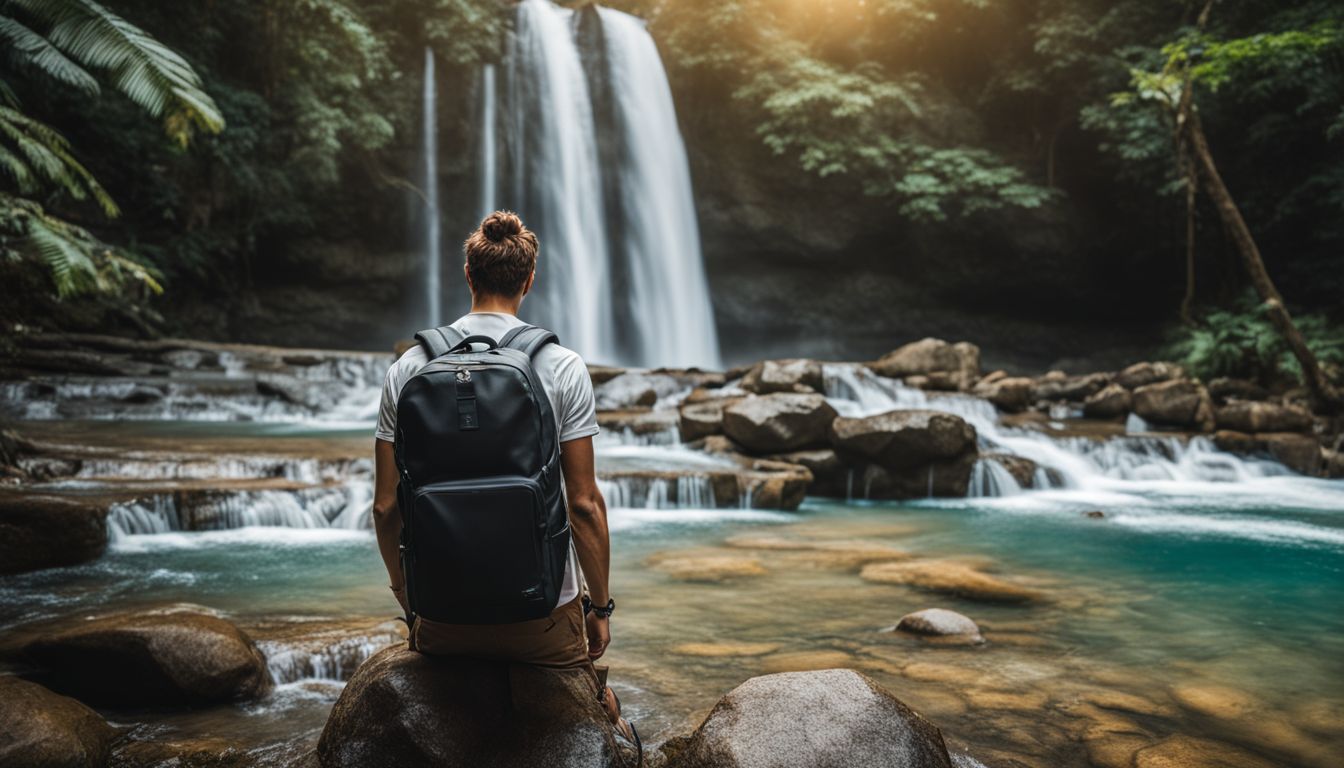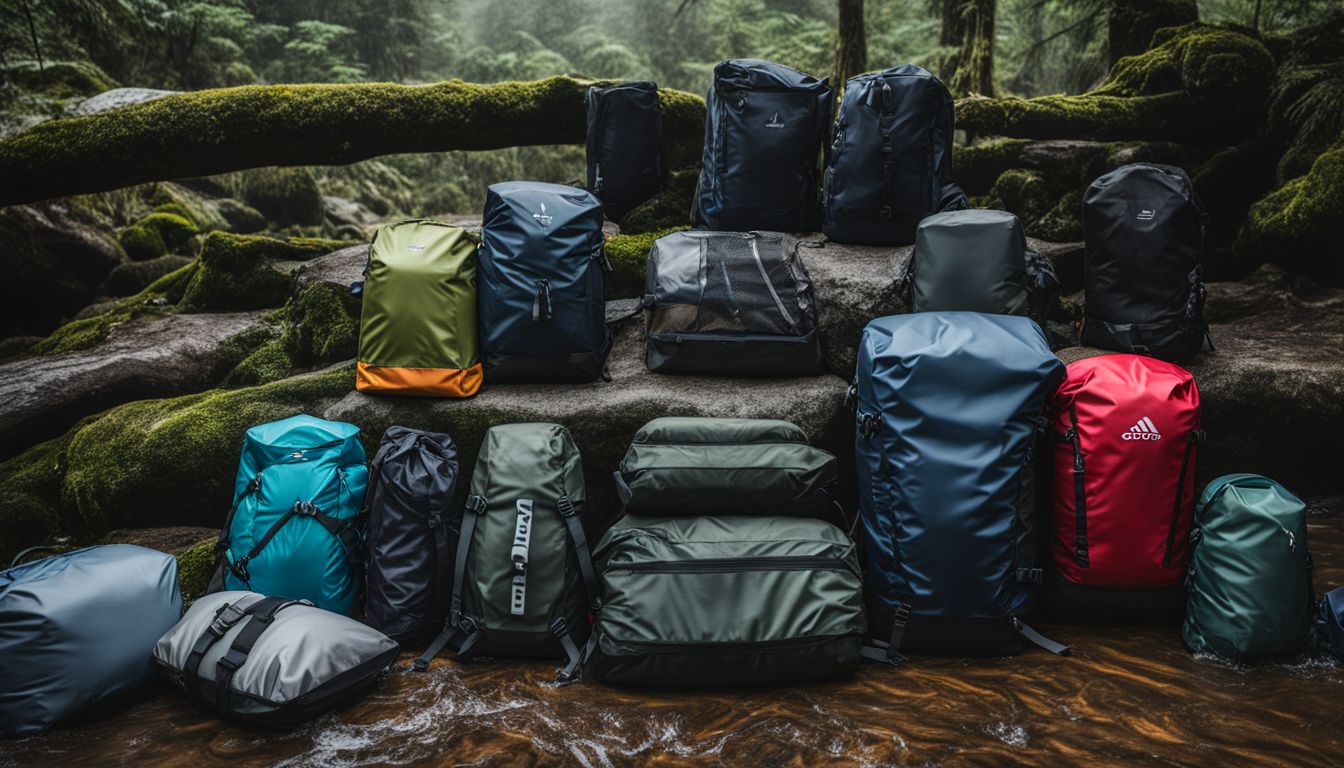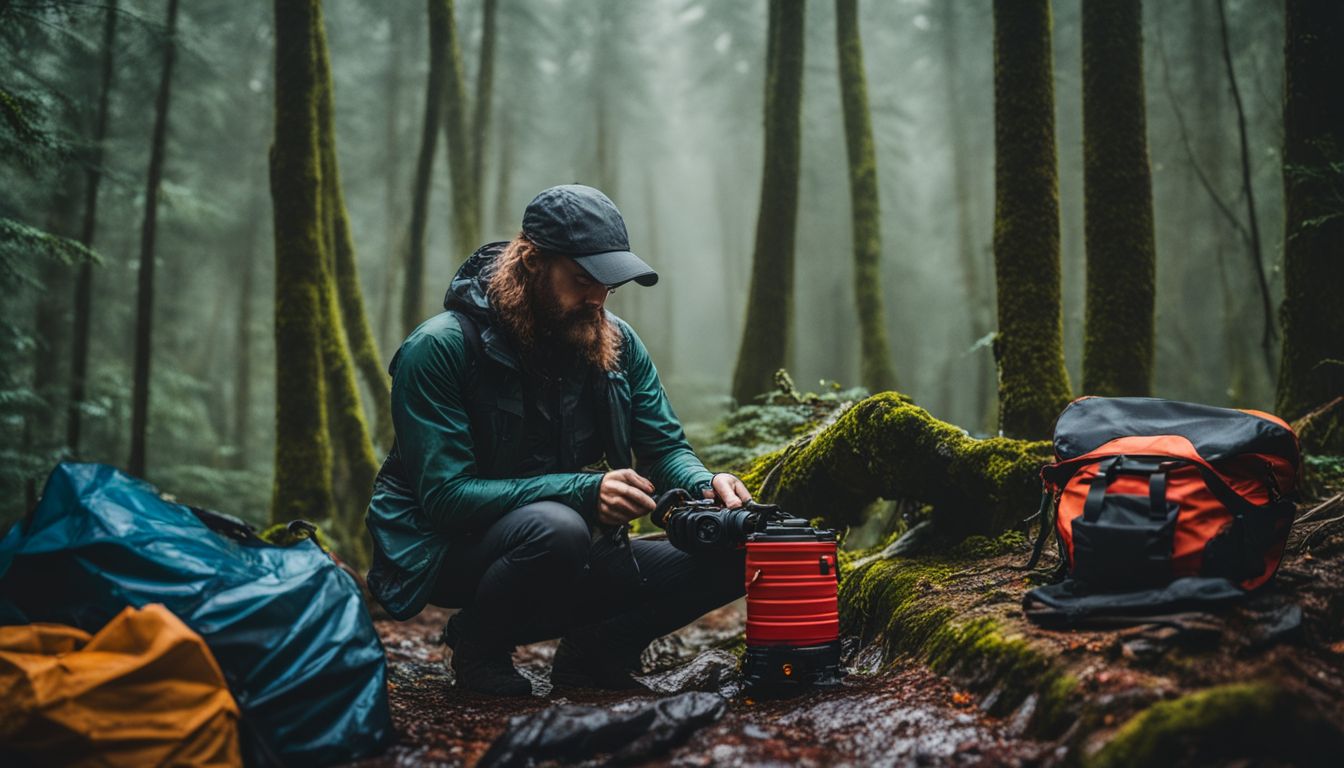Imagine setting out on an epic adventure, only to have your gear soaked by an unexpected downpour or river crossing. Avoiding such mishaps is not just about having the right gear; it’s about mastering waterproof packing techniques that can mean the difference between a trip derailed by moisture and one that’s smooth sailing from start to finish.
As an expert with years of experience braving the elements, I’ve learned first-hand how crucial it is to protect your belongings from water.
Waterproofing isn’t merely a convenience—it’s a necessity for travelers and adventurers alike. Did you know that sturdy, water-resistant packing cubes can secure even sensitive items such as tablets? This article will dive into proven strategies for keeping everything dry no matter what Mother Nature throws at you.
And trust me, when your electronic devices and clothes emerge unscathed after a deluge, you’ll be thankful you took the time to learn these life-saving packing hacks. Keep reading; there’s more insight ahead!
Key Takeaways
- Waterproof packing is essential for travel, protecting belongings from water damage and ensuring they stay organized and accessible.
- Utilizing water – resistant packing cubes, employing the Pack Float Technique for short water crossings, covering furniture in plastic for ocean moves, and lining backpacks and suitcases with dry bags are effective waterproof packing techniques.
- When choosing waterproof packing materials, it’s important to understand the differences between water-resistant and waterproof materials and assess durability, seal quality, intended use cases, environmental factors, zippers/closures quality.
Importance of Waterproof Packing for Travel

Waterproof packing is essential for travel to protect belongings from water damage and keep them organized and accessible. It provides peace of mind when navigating through various environments and weather conditions, ensuring that your items stay dry and in good condition throughout your journey.
Protection Against Water Damage
Water can ruin your travel plans and valuable stuff. Items like clothes, electronics, and important papers need to stay dry. Use good packing methods to stop water from getting in.
Waterproof packaging is a must for ocean trips because it keeps everything safe.
For extra safety, put armchairs and other big items in thick plastic before you move them across the sea. This stops water from damaging things during long journeys. Always check if the materials are strong enough to protect against poking or breaking.
Next up is keeping your things organized while making sure they’re protected from water.
Keeping Belongings Organized and Accessible
Protecting your stuff from water is important, but so is finding them when you need them. Organize your things with packing cubes like the Gonex compression packing cubes or the well traveled compression packing cubes.
They keep your clothes and gear neat inside your carry-on suitcase or rucksack. You can see everything at a glance without digging around.
Packing smart means knowing where everything is. Use lean travel premium compression packing cubes to separate shirts, socks, and other items. Put the most used things on top or in outside pockets of your luggage for quick grab-and-go access.
This way, even if you’re in a hurry at the airport or setting up camp by the lake, you still find what you need fast.
With these techniques, every adventure starts smooth. Your backpack feels balanced because heavy items sit at the bottom close to your back—all thanks to good organization and planning ahead!
Top Waterproof Packing Techniques

Utilize water-resistant packing cubes to keep your belongings organized and protected. Learn about the pack float technique for short water crossings and how to line backpacks and suitcases with dry bags for added protection.
Utilizing Water-Resistant Packing Cubes
Water-resistant packing cubes help keep your clothes and gear dry. Imagine you’re on a trip and cross a stream or get caught in the rain. Your stuff stays safe inside these tough cubes.
They are great for any day, whether you go to the beach or hit the gym. You can pack them in your carry-on luggage or toss them into your storage unit without worry.
These travel accessories are smart choices because they last long and protect against moisture. Use them to sort your items so you can find things quickly. Packing cubes come from different materials; some even use recycled materials, which is good for Earth.
They work well for all kinds of travel – adventure or business – and everyday life too, keeping electronics and other valuables secure.
The Pack Float Technique for Short Water Crossings
One effective way to protect your belongings during short water crossings is the Pack Float Technique. This technique involves sealing up your backpack with twists and bands and floating it across the water. Here are some important points to consider for this method:
- Seal all openings: Before attempting the Pack Float Technique, make sure all zippers and openings of your backpack are securely closed to prevent water from seeping in.
- Use durable materials: Opt for a heavy-duty plastic bag or a specifically designed dry bag that can withstand water exposure without tearing or leaking.
- Secure the closure: Ensure that the top of the bag is twisted tightly and secured with rubber bands or nylon straps to create a watertight seal.
- Test for buoyancy: Before entrusting your belongings to the pack float, conduct a trial run in shallow water to ensure that your pack floats and remains stable on the surface.
- Extra precautions: Always carry extra plastic bags or dry bags as backups in case the initial one gets damaged during packing or unpacking.
Covering Furniture in Plastic for Ocean Moves
When moving across the ocean, it’s important to protect your furniture from potential water damage. Here are the steps for covering furniture in plastic:
- Wrap each piece of furniture with heavy – duty plastic sheeting, ensuring that it is tightly sealed and secured with waterproof tape.
- Place padding or cardboard around sharp corners to prevent tearing through the plastic during handling and transport.
- For extra protection, consider using water – resistant furniture covers as an added layer against moisture and humidity.
- Before securing the plastic, ensure that all surfaces, especially wooden or metal parts, are completely dry to prevent mold and mildew growth.
- Lining Backpacks and Suitcases with Dry Bags
Lining Backpacks and Suitcases with Dry Bags
Keep your belongings safe from water damage by lining your backpacks and suitcases with dry bags. Here’s how to do it:
- Choose the right size of dry bag for your backpack or suitcase, ensuring a snug fit without overstuffing.
- Place items that need the most protection inside the dry bag, such as electronics, documents, and clothes you want to keep dry.
- Squeeze out excess air before sealing the dry bag to ensure a tight closure.
- Utilize multiple smaller dry bags for better organization within your luggage, separating different categories of items.
- Consider using colored or transparent dry bags to easily identify contents without having to open them.
Ultralight Rucksack Packing for Waterproof Efficiency
To pack an ultralight rucksack for waterproof efficiency, start by lining the inside with a trash compactor liner to keep your items dry in case of rain or accidental spills. Fill the pockets with lightweight essentials like water bottles, snacks, and a bathroom kit for quick access.
Consider purchasing a rain cover as an initial defense against wet weather conditions. When packing, restrict the size of the backpack and only carry what you need for the near future to maintain ultralight travel principles.
A simple ultralight packing list can help travelers pack efficiently with just one bag. Additionally, when adventuring around rivers and creeks, utilize specific techniques to ensure your backpack remains waterproof despite potential exposure to water elements.
Choosing the Right Waterproof Packing Materials
When it comes to selecting the right waterproof packing materials, it’s important to consider the differences between water-resistant and waterproof materials. Assessing durability and seal quality will help ensure that your belongings stay dry and protected during travel or outdoor activities.
Water-Resistant versus Waterproof Materials
Understanding the distinction between water-resistant and waterproof materials is critical in selecting the right gear for your needs. These terms are not interchangeable, and choosing incorrectly could lead to water damage. Consider the different characteristics and applications of each type to ensure the utmost protection for your belongings.
| Feature | Water-Resistant Materials | Waterproof Materials |
|---|---|---|
| Breathability | More breathable, allowing air to pass through | Less breathable due to a sealed or membrane layer |
| Weight | Typically lightweight and suitable for everyday use | Usually heavier and ideal for extreme conditions |
| Protection Level | Provide protection against light rain or splashes | Offer full protection against prolonged submersion |
| Material Composition | Often treated fabrics that repel water | Constructed with a waterproof membrane sandwiched between layers |
| Durability | Varies, but generally less durable against heavy water exposure | Designed to withstand harsher, wet conditions over time |
| Seal Quality | Seams may let water in during heavier downpours or immersion | Seams are typically sealed or taped to prevent water ingress |
| Use Cases | Everyday carry bags, light outdoor use, and urban wear | Outdoor adventures, water sports, and high-risk water exposure environments |
Selecting the correct material hinges on your intended use. Aim for water-resistant fabrics when you need a lightweight and breathable option for daily tasks or light rain conditions. Reach for waterproof materials to defend against serious water challenges, like boating or heavy rain adventures. Your gear’s performance depends on the right choice, ensuring your belongings stay dry and secure.
Assessing Durability and Seal Quality
When evaluating durability and seal quality of waterproof packing materials, it’s essential to consider the intended use and environmental factors. Look for materials that are tear-resistant and have strong seams, such as reinforced stitching or welded seams, to ensure they can withstand rough handling during travel.
Additionally, inspect the quality of zippers, buckles, or closures to ensure they are water-tight and durable. Choose materials with high-quality coatings or laminates for better protection against water penetration.
It’s also important to check for any certifications or standards indicating the material’s level of water resistance or waterproofing.
Practical Applications for Waterproof Packing
Waterproof packing techniques are particularly useful for outdoor adventures and water sports, as they can protect your gear from getting wet. Additionally, waterproof packing is essential when relocating across bodies of water or for day-to-day use to keep electronics and valuables safe and dry.
Outdoor Adventures and Water Sports
When engaging in outdoor adventures and water sports, ensuring that your belongings stay dry and secure is crucial. Here are some practical tips to consider:
- Utilize water – resistant packing cubes to keep clothes, electronics, and other essentials dry and organized.
- Employ the pack float technique for short water crossings, securing your backpack or rucksack with a waterproof cover or dry bag to prevent water damage.
- Consider using specialized dry bags to safeguard electronic devices, important documents, and valuables during water activities.
- Choose gear made from durable and reliable waterproof materials to protect against unpredictable weather conditions.
- When relocating across bodies of water for outdoor adventures, ensure that all luggage and equipment are adequately packed in waterproof containers or bags.
Relocating Across Bodies of Water
When it comes to relocating across bodies of water, whether for a permanent move or a temporary trip, waterproof packing is crucial. Here are some important techniques and tips to ensure your belongings stay safe and dry during the transit:
- Invest in high – quality waterproof containers, such as dry bags, to store smaller items and electronics that could be damaged by water exposure.
- Use durable plastic coverings or tarps to protect furniture and larger items during transportation, especially in the event of rain or snow.
- Organize your belongings into categories and pack them in waterproof containers based on their use or function to stay organized and ensure extra protection.
- Consider using water – resistant packing cubes to keep clothes separated and protected, especially when dealing with unexpected wet conditions during travel.
- When crossing short bodies of water, utilize the “Pack Float” technique by sealing your packed items in a waterproof bag or container for extra buoyancy and protection.
- Prioritize water – repellent materials when selecting luggage or backpacks for transporting your belongings across bodies of water.
- When packing delicate items like documents or passports that must remain completely dry, consider double-bagging them inside waterproof containers for added security.
- Take into account the potential impact of humidity during the transit process and use desiccants to absorb any moisture that might seep into your packed items.
- Assess the seal quality of all waterproof containers used for packing and make any necessary adjustments before setting out on your journey.
- Secure zipped compartments on bags with additional protective covers or flaps to prevent any accidental exposure to water while moving across bodies of water.
Day-to-Day Use for Electronics and Valuables
Day-to-Day Use for Electronics and Valuables
- Invest in a high – quality waterproof phone case or pouch to protect your smartphone from accidental spills, rain, or splashes while on the go. Look for a case with a secure seal and reliable reviews for maximum protection.
- Use a waterproof dry bag or pouch to safeguard your wallet, passport, and other important documents during outdoor activities, beach days, or even just commuting in wet weather. This extra layer of protection can offer peace of mind against unexpected moisture.
- Consider using a water – resistant laptop sleeve or cover for your computer when working in outdoor or unpredictable environments. This added shield can help prevent water damage from rain, spills, or humid conditions.
- Utilize waterproof packing cubes or pouches to organize and protect small electronic accessories like chargers, earphones, and power banks when traveling or just carrying them day-to-day. These specialized containers can keep everything dry and easily accessible.
- When storing valuable items at home, such as jewelry, important documents, or sentimental objects like photographs, consider placing them in a waterproof safe or container for extra security against potential flooding or water-related accidents.
Conclusion
In conclusion, waterproof packing techniques are crucial for protecting your belongings from water damage during travel and outdoor adventures. These strategies are practical and efficient, offering simple yet effective ways to keep your gear dry and organized.
How can you apply these methods to ensure the safety of your valuables on your next trip? By implementing these techniques, you can significantly improve the protection of your items and avoid potential damage caused by water.
Remember that proper waterproof packing not only safeguards your possessions but also enhances your overall travel experience. So, take charge and make use of these valuable tips to safeguard your belongings on all future journeys!
For those looking to master the art of lightweight travel while keeping their gear dry, explore our guide on ultralight rucksack packing.
FAQs
1. What are waterproof packing techniques for travel?
Waterproof packing techniques are ways to keep your clothes and travel essentials dry when you pack them in your baggage.
2. Why is learning about waterproof packing important?
Learning to pack this way helps protect your things from getting wet, whether it’s raining or if something spills inside your luggage during trips.
3. Can I find information on the web about waterproof packing?
Yes, you can use browsers like Internet Explorer to search the web for tips and tricks on how to pack items so they stay dry while traveling.
4. Do I need special bags for waterproof packing?
It helps to have bags made to keep water out, but you can also use plastic bags or wrap things tightly with layers of protection as a part of your waterproofing process.

